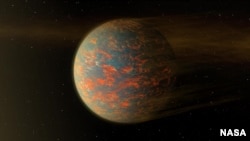Astronomers have mapped a two-faced planet where one side is “completely molten” and the other “almost completely solid.”
55 Cancri e, which is 40 light years away from Earth, is considered a “super Earth,” meaning it’s rocky. It’s twice as big as Earth and eight times as massive. The planet orbits its star so closely that a year lasts only 18 hours.
It’s also “tidally locked,” meaning that like our moon, the same side always faces its star.
That means the temperatures on the two sides of the planet vary greatly, with the hot side reaching 2,500 degrees Celsius, while the cooler side is about 1,100 degrees.
"We haven't yet found any other planet that is this small and orbits so close to its parent star, and is relatively close to us, so 55 Cancri e offers lots of possibilities," said Brice-Olivier Demory of Cambridge University's Cavendish Laboratory, the paper's lead author. "We still don't know exactly what this planet is made of - it's still a riddle. These results are like adding another brick to the wall, but the exact nature of this planet is still not completely understood."
The mapping of the planet was done using infrared data from NASA’s Spitzer Space Telescope, which revealed one molten half and one solid half. Astronomers also noted that, unlike on Earth where heat is circulated through the atmosphere, on 55 Cancri e there is little transference of heat from one side to the other.
55 Cancri e was discovered in 2011 and has been studied in detail. At one point it was thought to be a “water world,” and it was later thought to be made of diamond.
"We have entered a new era of atmospheric remote sensing of rocky exoplanets," said study co-author Nikku Madhusudhan, from the Institute of Astronomy at Cambridge. "It is incredible that we are now able to measure the large scale temperature distribution on the surface of a rocky exoplanet."
One reason researchers think heat does not circulate could be “either a complete lack of atmosphere, or one which has been partially destroyed due to the strong irradiation from the nearby host star.”
"On the day side, the temperature is around 2,500 degrees Celsius, while on the night side it's about 1,100 degrees - that's a huge difference," said Demory. "We think that there could still be an atmosphere on the night side, but temperatures on the day side are so extreme that the atmosphere may have evaporated completely, meaning that heat is not being efficiently transferred, or transferred at all from the day side to the night side."
Demory said the findings demonstrate the difficulty astronomers will have detecting a planet like Earth.










